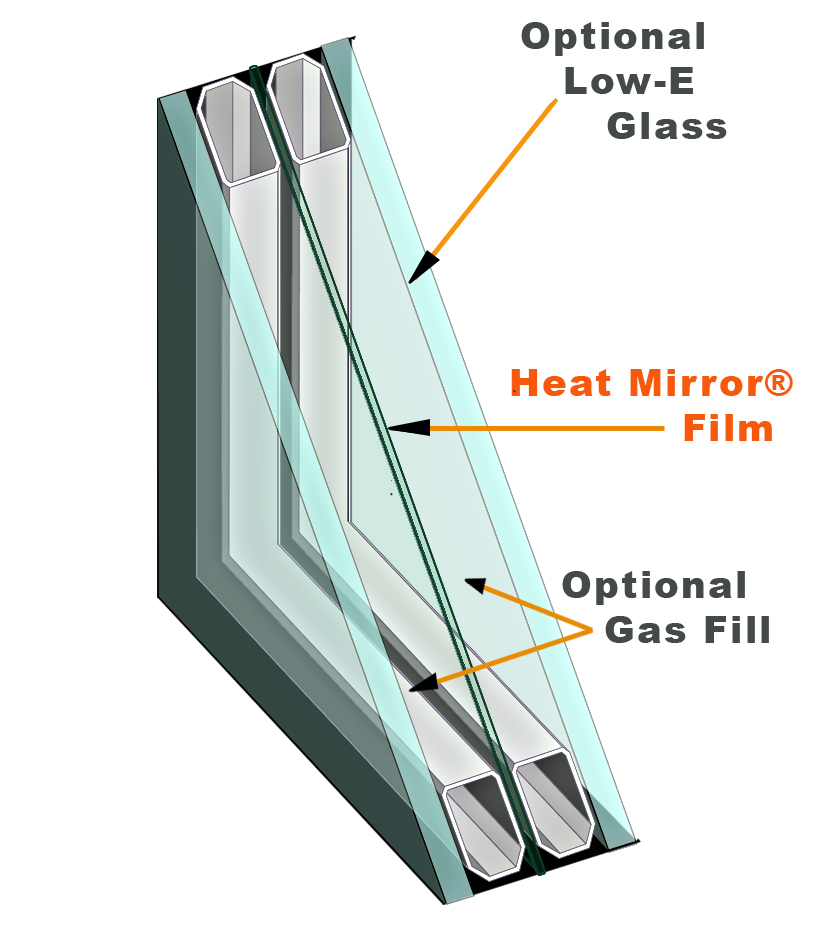I installed a houseful (18) of Marvin windows with Heat Mirror glazing in 1993 (NC Piedmont). They were effective but within 3 years most of them had lost their seal. Marvin was very cooperative and replaced all the windows at no charge, but with standard insulated glass. I've hesitated since then to spec Heat Mirror though I love the concept and the U-values they provide.
Delighted to hear that they are finally addressing the sealing problem with the cooperation. I hope this works.
(45 years ago I installed an 8' Anderson wood sliding patio door with their insulated glass in it in a house in the Adirondacks. Still hasn't lost its seal!)
Blog Post
Heat Mirror for Structural Sealant Glazings

I've been following the evolution of Southwall Technologies for years--well, decades. The company invented the low-emissivity coating in the 1970s, but rather than coat glass directly, the company coated plastic film, which it then suspended between panes of glass. This created two air spaces (triple glazing), further improving energy performance. The company called this suspended low-e film Heat Mirror.
Until now, Heat Mirror was an option for windows, but not large curtainwall glazing systems that rely on "structural sealant" to hold the pieces of glass in place. (Structural glazing now accounts fully a third of the glass going into commercial buildings, according to Southwall.)
That has now changed. Southwall Technologies and Dow Corning announced yesterday a new Heat Mirror system for structural glazing applications. You can find a more in-depth article about this that I just posted on Environmental Building News, but here's the short take: The new Heat Mirror "S" glazing system uses a slightly reformulated suspended film from Southwall and a two-part secondary silicone sealant from Dow Corning. The secondary sealant is key in Heat Mirror glazing units, because it has to keep the suspended film in place and taut for the life of the window.
In structural glazings, the old standby sealant for Heat Mirror glass, polyurethane, doesn't work very well, because polyurethane is an organic material that degrades over time with UV light exposure. (It works with windows, because the edges of the glazing units are fully protected by the frame.)
Silicone is inorganic and is far less damaged by UV. This is necessary, because the sealant used between glazing units in structural glazing applications are exposed to the sun.
With this new development, the door is now open to very-high-performance triple and quadruple glazings with multiple low-e films in commercial buildings, where building owners and architects love installing glass--lots of it--and where the weight of that glazing is a key concern.
SUPPORT INDEPENDENT SUSTAINABILITY REPORTING
BuildingGreen relies on our premium members, not on advertisers. Help make our work possible.
See membership options »Performance properties of various glazing configurations using Heat Mirror S are provided in the full Environmental Building News article. For example, with one layer of clear glass, one layer of low-e glass, Heat Mirror 88 (the clearest of Southwall's low-e films), and argon gas-fill in a 1"-thick glazing unit, the unit U-factor is 0.15, the solar heat gain coefficient (SHGC) is 0.58, and the total visible light transmission is 0.72.
While I continue to believe that we're often putting far more glass on commercial buildings than we should (see my Environmental Building News feature article "Rethinking the All-Glass Building"--log-in required), with Heat Mirror S, the energy penalty of adding a lot of glass can be a lot lower.
For more information:
Product review in Environmental Building News
Southwall Technologies
Palo Alto, California
800-365-8794, 650-798-1200
Dow Corning
Midland, Michigan
800-248-2481, 989-496-4400
Alex Wilson is the executive editor of Environmental Building News and founder of BuildingGreen, Inc. In addition to this product-of-the week blog, he writes the weekly Energy Solutions blog. To keep up with his latest articles and musings, you can sign up for his Twitter feeds. Products covered in his product-of-the-week column are--or soon will be--listed in BuildingGreen's GreenSpec Directory.
Published November 10, 2010 Permalink Citation
(2010, November 10). Heat Mirror for Structural Sealant Glazings. Retrieved from https://www.buildinggreen.com/blog/heat-mirror-structural-sealant-glazings
Comments
I installed a houseful (18) o
Great to hear of more innovat
Great to hear of more innovation with structural technologies. Keep up the good work.



Add new comment
To post a comment, you need to register for a BuildingGreen Basic membership (free) or login to your existing profile.